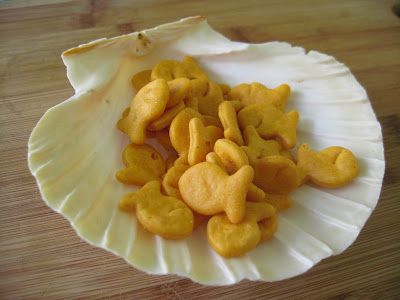No time for anything fancy on the feast of St. James? Still want to make it fun? A really simple idea is to just serve anything in a scallop shell. Since I had purchased the large shells for the Coquilles St.-Jacques dish, I realized how fun it would be to use for any serving on St. James day. The shells are available at many craft stores and kitchen stores, as well as online outlets like Amazon.
Try serving up a condiment or spice like sea salt pictured here.
The scallop makes a nice sized side dish for serving up salad or fresh fruit.
A fun dish for snack time, apple slices, orange wedges, carrot stick, etc. Pictured here are goldfish crackers since St. James was both a fisherman and a "fisher of men."
How about cookies?
It is a great little dish for a dessert, like ice cream for a warm July evening.
The possibilities are numerous. Enjoy!
Why a scallop shell?
The scallop shell is a common symbol of St. James and is
associated with travelers/pilgrims especially on the Camino de Santiago.
Earliest connection of the scallop shell to the Camino and saint James is dated
in the 10th century. The shell is commonly found on the shores of Galicia and
served as a proof of completion of the pilgrimage. In a practical sense, the
shell was the right size for gathering water to drink or for eating out of as a
makeshift bowl.
There is a legend with a couple versions linking St. James
to the shell. One says that after St.
James' death, his disciples took his body by ship to the Iberian Peninsula to
be buried. Off the coast a storm hit the ship, and the body was lost to the
ocean. After some time, the body washed ashore undamaged, covered in scallops. Another version states, that as the ship carrying St. James'
body approached land, a wedding was taking place on the shore. The young
bridegroom was on horseback, and on seeing the ship approaching, his horse got
spooked, and the horse and rider plunged into the sea. Through miraculous
intervention, the horse and rider emerged from the water alive, covered in
seashells.
There are two metaphors I have seen for the shells. The
grooves in the shell, which come together at a single point, could represent
the various routes pilgrims traveled, eventually arriving at a single
destination at the tomb of Saint James in Santiago de Compostela. The scallop
shell could also represent the pilgrim. As the waves of the ocean wash scallop
shells up on the shores of Galicia, God's hand also guides the pilgrims to
Santiago.
Whatever the meaning – the various symbolism and stories
associated with the scallop and St. James, make it a great visual for the feast
day.
Pin It







0 comments:
Post a Comment